Minari, or water parsley, is a fragrant vegetable with a crunchy texture. With the recent international interest in the film “Minari” by Korean-American director Lee Isaac Chung, the plant has become a symbol of Koreans’resilience and adaptability.
Most grasses in the wild contain toxic substances, so theytaste bitter in your mouth.Children’s natural rejection of that bittertaste comes from their instinct to protectthemselves from poisonous plants. Humandietary culture has developed based on theknowledge to distinguish between edibleand non-edible plants.
At first glance, water parsley (minari)and water hemlock (dok-minari, meaning“poisonous minari”) look similar. Theyboth have hollow stems and sharply serrated leaves. However, if you look closely, water parsley leaves have the shape ofan egg cut vertically, while water hemlockleaves are long and pointed, like the end ofa spear. Though they belong to the samefamily, one is edible and the other is not.
As minari contains no toxic substances, it can be eaten raw or cooked and hasbeen a popular ingredient in Korean cuisine since ancient times. In the 1920s, itwas so commonly consumed that its market price was listed in the newspapers. It isloved for its unique fresh taste and relatively richer scent than other herbs, and as ahollow-stemmed vegetable like water spinach (gongsimchae), it remains crisp andrefreshing even when slightly blanched
Let’s look at the recipe for minariganghoe, or minari rolls, introduced in theJoseon Dynasty cookbook Siui Jeonseo(Compendium of Proper Cookery), writtenin the late 19th century. Remove the rootsand leaves, trim the stems and blanch them.Slice pan-fried egg sheets, brisket, rockear mushrooms (manna lichens) and redchili peppers into thin strips, then tie all theingredients with a minari stem, placing apine nut in the middle of the roll. Put themneatly on a plate and eat with red pepperpaste mixed with vinegar. The key to thisdish is the fragrant, crunchy minari, whichbinds the other ingredients together.
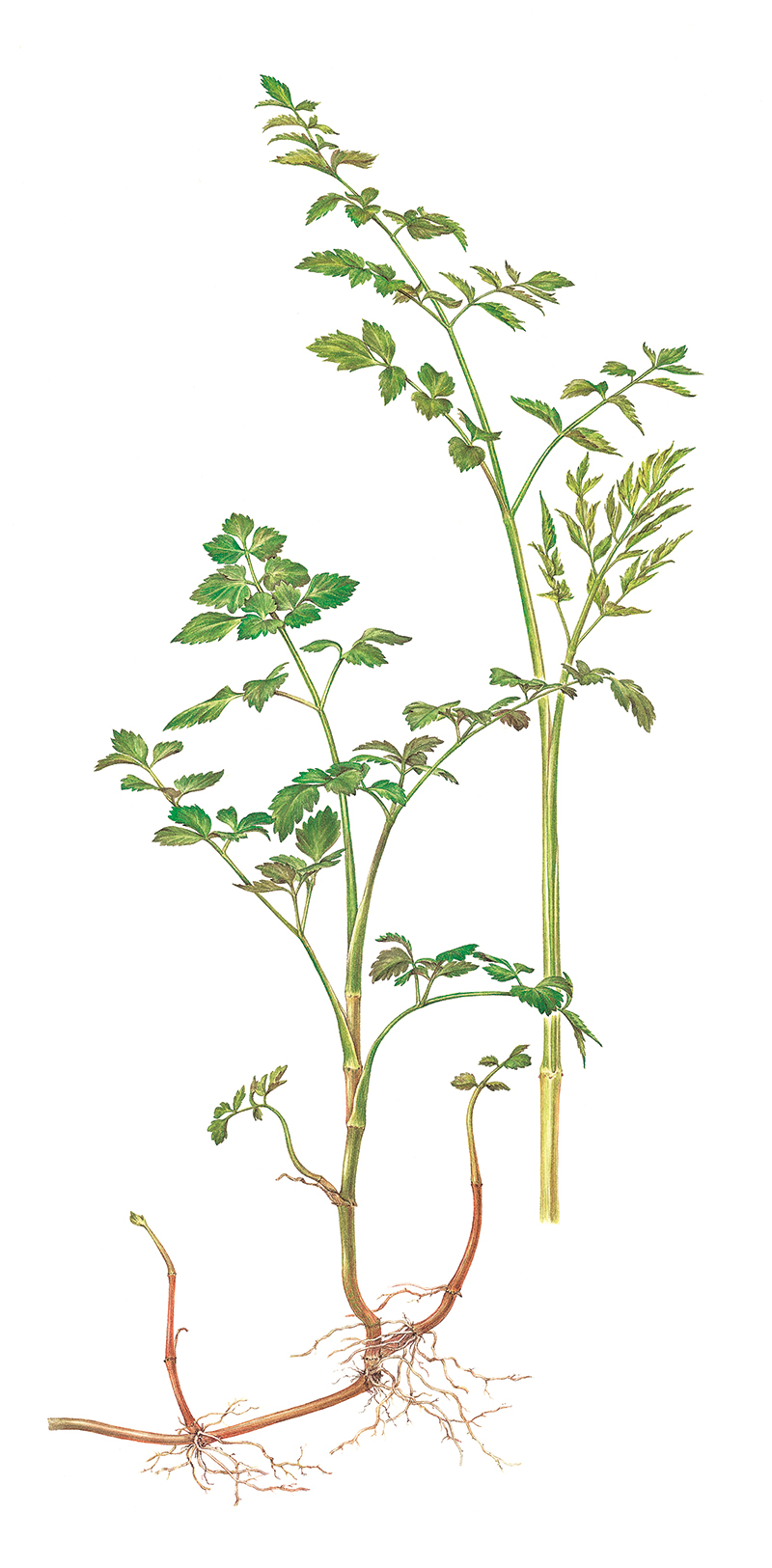
Minari, a cool and refreshing summer ingredient with aslightly peppery taste, is rich in vitamins, minerals and fiber.According to Dongeui Bogam (Exemplar of Korean Medicine)from the 17th century Joseon Dynasty, it quenches the thirst,clears the head and is effective in treating headaches andvomiting.
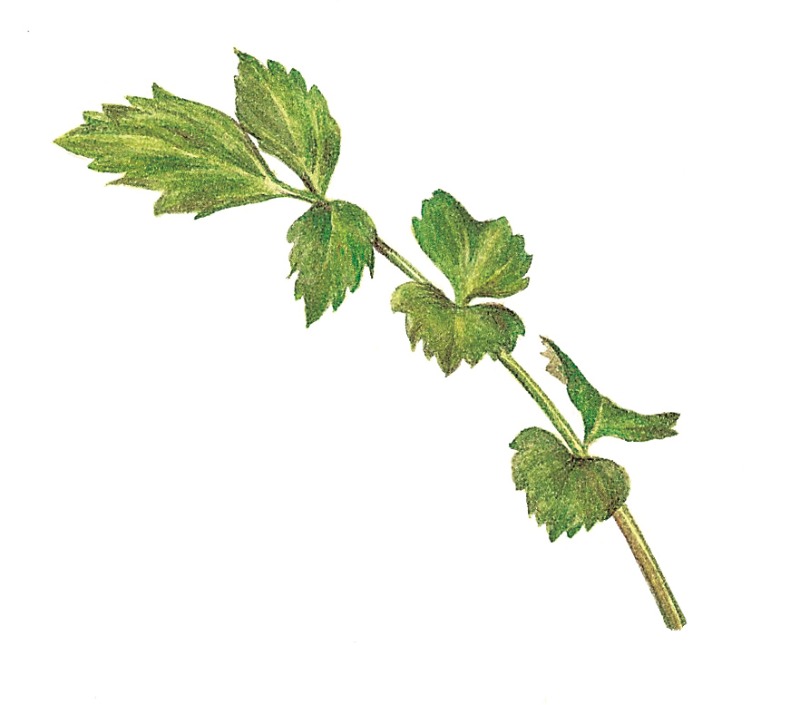
Minari leaves have sharp sawtooth edges. The shape ofthe leaf resembles that of an egg cut vertically.
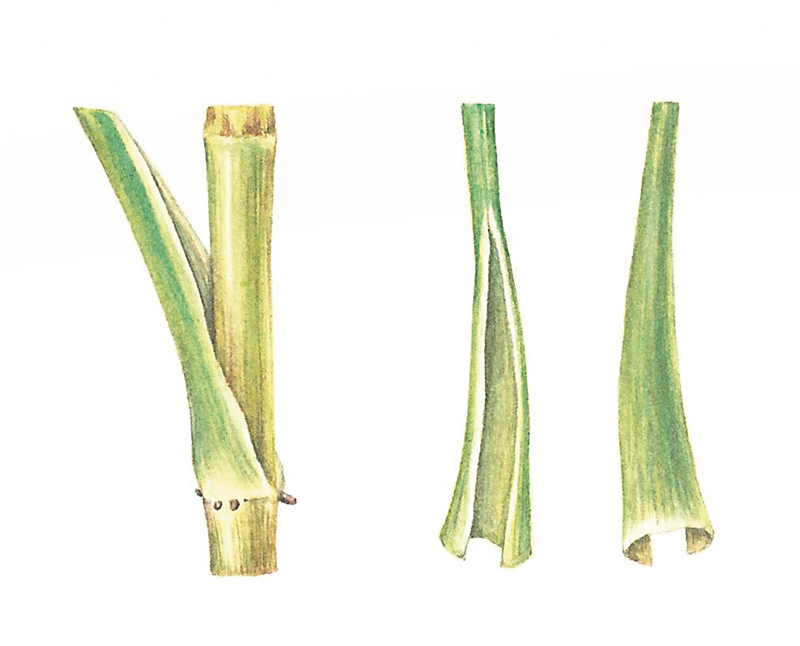
Moist and resilient, minari stems have a refreshing,crunchy texture. There are two major types of the green: Ricepaddy minari, grown in water, has a hollow stem, while thestems of minari grown in dry fields are relatively solid.
Special Texture
Why do we love this crispy, crunchy texture? Neuroanthropologist John S. Allen gives three reasons in his book, “The Omnivorous Mind” (2012). First, humans are primates who have insect-eating relatives.Second, the preference for crispy food increased when food began to be cooked with fire, making ingredients crispier than in their raw state. And third, the crispy texture of plants signifies their freshness. Fresh vegetables, whose cell walls are filled with water, burst to produce a crispy sound when chewed. By contrast, vegetables that have been stored for a long time are pulpy and tough, as their moisture has largely dried out.
Water-filled minari maintains its crispiness when blanched or stir-fried, andeven when pickled or used in kimchi. This is because the sour-tasting organic acids strengthen the cell walls. But by far the best way to enjoy the crispy taste is to go to a farm for raw, freshly harvested minari. penes. Chewing on a mouthful of minari will take you into the midst of a dense forest of pines, firs and cedars as the terpene substances such as pinene and myrcene explode in your mouth. Minari also contains aromatic substances that bring to mind citrus fruits, lime peel, ginger and galangal. Adding minari to fish-baseddishes can therefore help reduce any fishy smell. Clearly, there is a scientific reason for using it in dishes such as maeuntang, spicy fish stew.
Pleasant Aroma
The fragrant scent of minari goes well with the savory flavor of soybean paste. It wasalready common to add minari to soybean paste stew when, on April 2, 1939, theChosun Ilbo newspaper introduced a recipe for minari cured in soybean paste: “Washthe minari clean, soak it in hot water for Hanjae minari, grown in Hanjae, Cheongdo County, North GyeongsangProvince, is famous nationwide. Hanjae comprises the villages of Chohyeon-ri, Eumji-ri, Pyeongyang-ri and Sangri, where local volcanic rock soil, with its excellent drainage, is perfect for minaricultivation. Minari is largely divided into varieties grown in rice paddies or in dryfields. Rice paddy minari, which grows in water, has a hollow stem as describedabove. On the other hand, field minari has a fuller stem. Hanjae minari is cultivatedin a way that produces a middle ground between the two types. The stems are mostly full, and the plant is also crispy with a pleasant scent. Minari harvested in springis often eaten raw with grilled pork belly in place of the usual lettuce, served together with sliced garlic and soybean paste for relish. The refreshing scent of the vegetable covers the greasiness of the meat. It can also be lightly cooked on the grill alongside the meat.
The scent of minari comes from a class of volatile substances called terp about an hour, then spread soybean paste in a bowl and place a thinof minarion top. Spread anotherof soybean paste and minari on top and put a lid onthe bowl. It tastes wonderful when taken out and eaten two days later. The better thesoybean paste, the better the taste.”
The fragrant substances in plants are basically weapons to defend against external invaders, such as bacteria and insects.Therefore, minari has a stronger scent when grown in fields than in water. Minarithat grows in the mountains or in the wild is called dolminari, the prefix dol meaning“wild.” It has an even stronger scent than minari grown in fields because it producesa lot of resistant, fragrant substances to survive in a barren environment.
Minari also contains various antioxidants and studies are underway to explain its antioxidant, anti-inflammatory and liver protective effects. It is commonly believedthat adding minari to blowfish dishes helps to detoxify any blowfish poison that mightremain. But as this has not been proven, it should rather be understood that minari is added to enhance the flavor.
To someone who has never tasted it, minari – and its consumers – may seemstrange. However, it isn’t particularly hard to get used to. The carrots and celery usedin European flavor bases such as mirepoix and sofrito are all relatives of minari. If youlike the crispy texture of celery, minari will also grow on you in no time. It can be usedinstead of basil to make pesto, and also works well stir-fried and added to oil pasta.
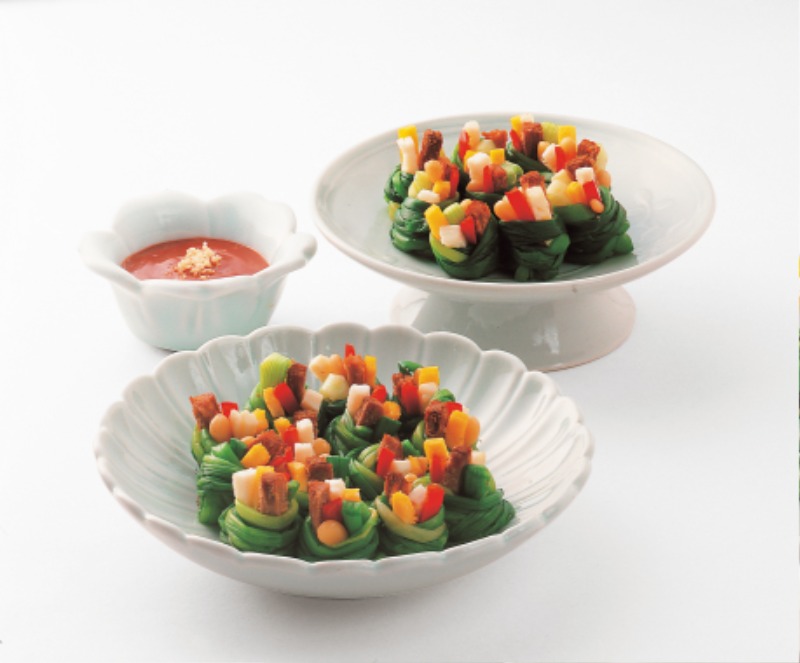
Minari ganghoe, or minari rolls, made with assorted ingredients such as fried egg strips, stir-fried beef and mushrooms, all tied with blanched minari stems, are eaten dipped in red pepper paste with vinegar. They were served on the king’s table or at court banquets during the Joseon Dynasty.
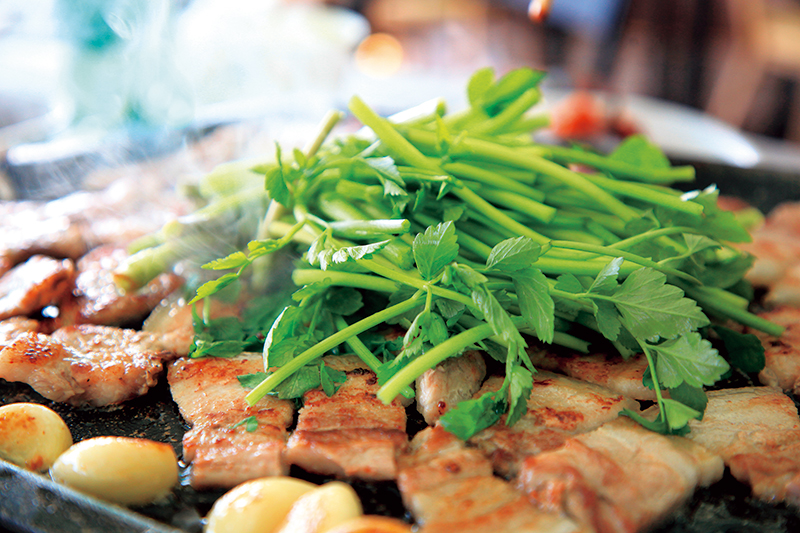
Minari goes very well with juicy pork belly, either fresh or grilled with the meat.
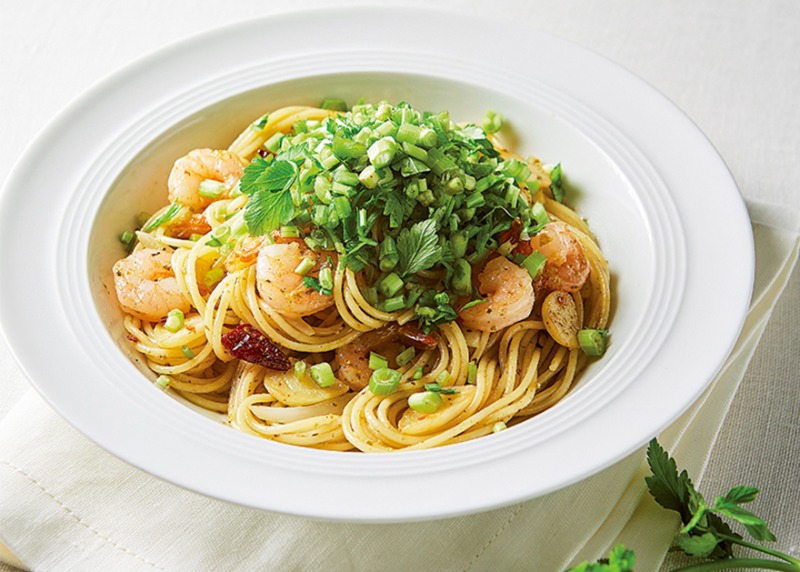
Minari has a strong fragrance and is known in English as water parsley, water dropwort, or Asian parsley.These days, it is a popular ingredient for pasta.
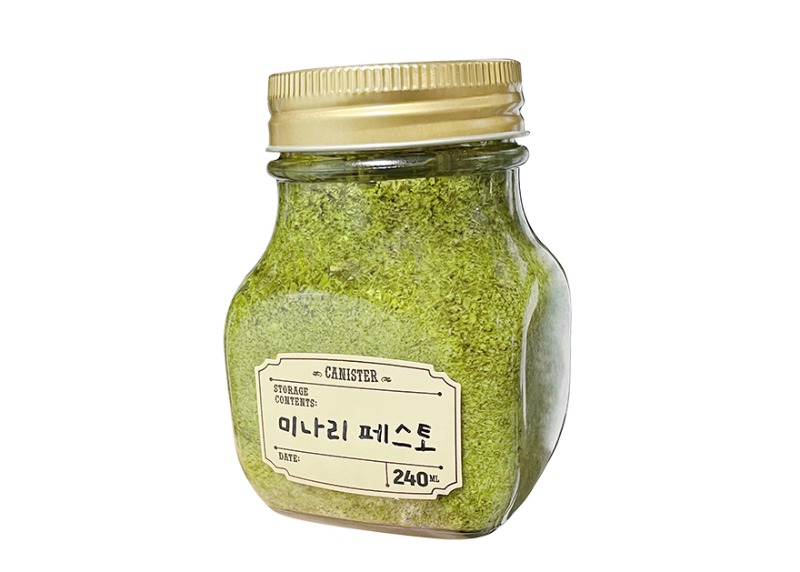
Pesto made with chopped minari is not only used with pasta but is delicious when spread on bread, just like basil pesto or spinach pesto.
Resilient Vitality
“Minari grows well anywhere.” So saysthe grandmother to her little grandson inthe film “Minari,” directed by Lee IsaacChung. It isn’t easy for a Korean familyto settle down in an unfamiliar place likeArkansas. The life of an immigrant, whereanxiety and hope intersect, can leave onewondering whether or not it is possible totake root in a new place, as minari can. Atfirst, minari seems to simply be a resilientplant that grows well anywhere, but in fact,it has to struggle with many surroundingthreats.